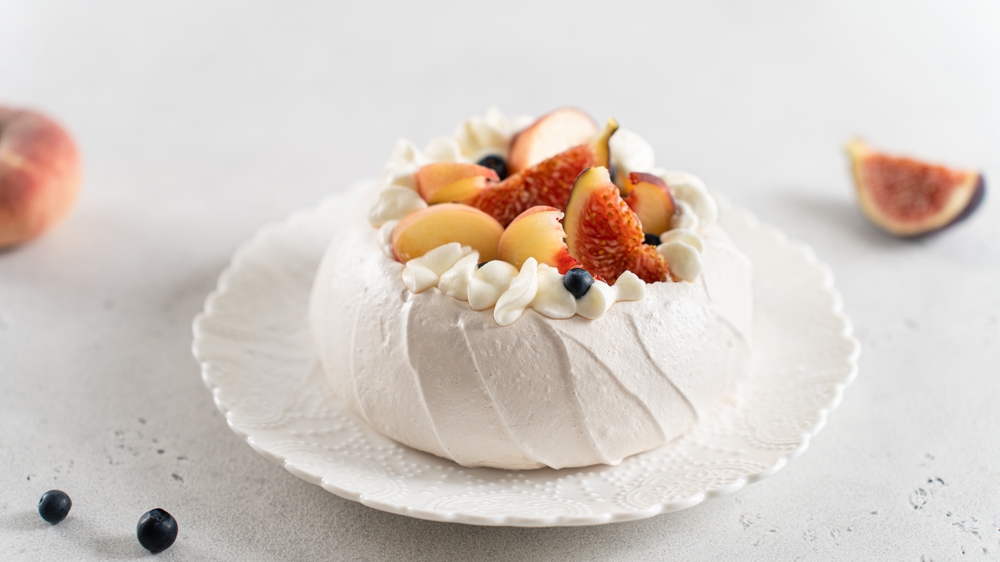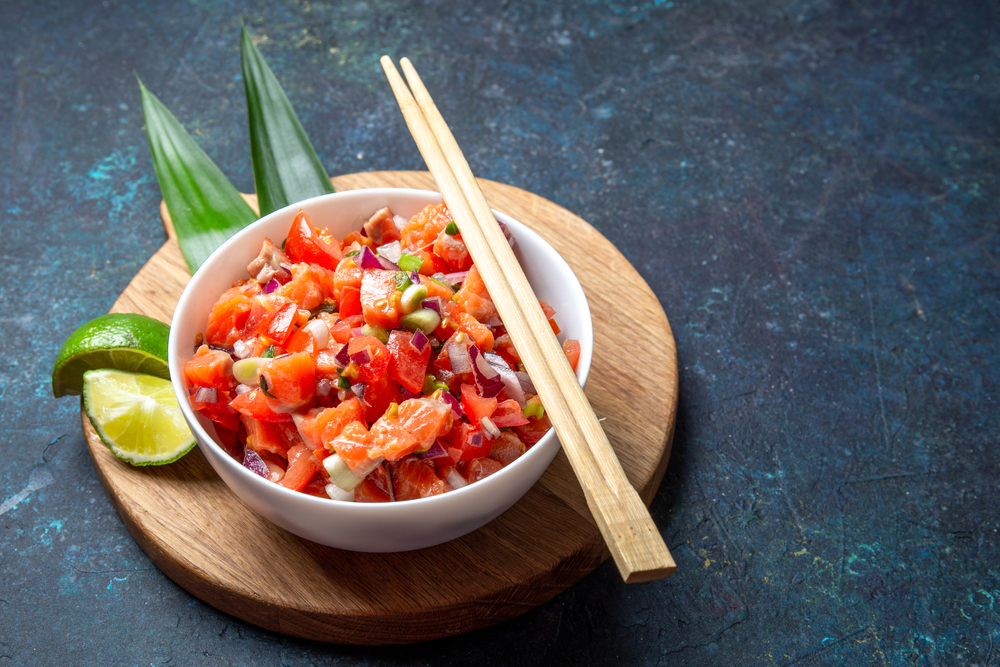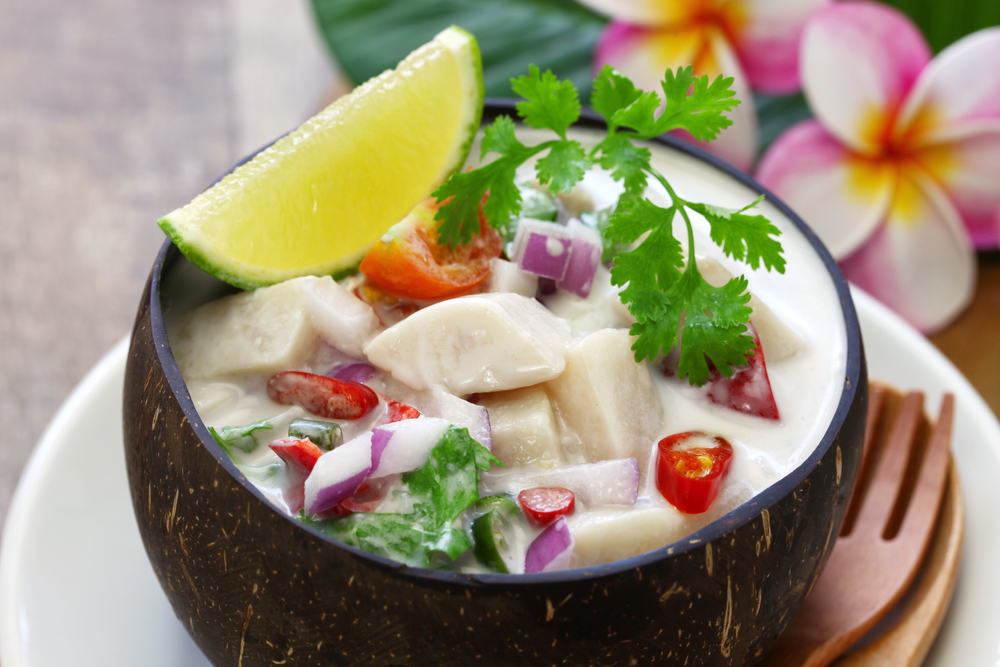1. Pavlova – A Sweet Meringue Delight
What is Pavlova?
Pavlova is an iconic dessert in Oceania, particularly beloved in Australia and New Zealand, with both countries claiming its origin. This delectable sweet treat is named after the Russian ballerina Anna Pavlova, who visited the region in the 1920s. Pavlova is distinguished by its light, crisp crust and soft, marshmallow-like center, usually topped with whipped cream and fresh fruits. Its festive appearance makes it a popular choice for celebrations and holiday feasts, symbolizing a culinary homage to the artistry of the famous dancer it’s named after.
How is Pavlova made?
The creation of a Pavlova masterpiece begins with the beating of egg whites until stiff peaks are formed, to which caster sugar is gradually added to create a glossy meringue. A touch of acid, typically from vinegar or lemon juice, is mixed in with cornflour to stabilize the structure. This mixture is then shaped into a circle on a baking tray and cooked at a low temperature. The key is a long, slow baking period, ensuring the outer layer crisps while the inside stays soft and fluffy. After cooling, it is garnished with whipped cream and a bountiful array of fresh fruits.
Tips for making the perfect Pavlova at home
Creating a visually stunning and delicious Pavlova requires a few insider tips. Ensure that the egg whites are at room temperature before whipping, as this will yield a more voluminous meringue. Be meticulous in gradually adding the sugar to fully incorporate it into the egg whites for a glossy finish. It’s critical to avoid opening the oven door while the Pavlova is baking and cooling to prevent collapse. Lastly, adorn your Pavlova with the whipped cream and fresh fruit toppings just before serving to maintain its delicate texture.

2. Hangi – A Traditional Maori Feast
What is a Hangi?
A Hangi is a traditional Maori cooking method using heated rocks buried in a pit oven. This age-old technique is much more than just a way to prepare meals; it is a social event integral to Maori culture in New Zealand and a celebration of togetherness and community. The Hangi feast traditionally includes a variety of meats and vegetables, all infused with the distinctive smoky, earthy flavors imparted from the subterranean cooking process.
How is Hangi prepared?
The preparation of a Hangi begins with the digging of a pit in the ground, into which a fire is lit, and stones are placed on top to heat up. Once the stones are hot enough, the embers are removed, and food baskets are carefully placed on the stones. These baskets contain various ingredients enveloped in leaves to retain moisture. The entire pit is then covered with soil to trap the heat and allow the food to cook slowly over several hours, resulting in tender, flavorful dishes with a unique smoky essence.
Traditional ingredients used in a Hangi
The ingredients used in a Hangi typically feature a selection of meats like lamb, pork, or chicken alongside vegetables such as sweet potatoes (kumara), carrots, and potatoes. Additionally, Maori bread (rewena), fish, and sometimes puddings find their way into the mix. The variety of foods used can be attributed to available resources and the personal preferences of the community, each contributing its unique flavors to this communal dining experience.
3. Lomi Lomi Salmon – A Hawaiian Delicacy

What is Lomi Lomi Salmon?
Lomi Lomi Salmon is a traditional Hawaiian dish and a staple at any luau, which is a Hawaiian feast. It is a refreshing salad that embodies the flavors of the Pacific and is known for its distinctive combination of salted, diced salmon with the freshness of tomatoes, onions, and sometimes scallions or green onions. Lomi Lomi literally translates to “massage” in Hawaiian, a reference to gently massaging the ingredients together which allows the flavors to meld beautifully.
How is Lomi Lomi Salmon made?
To make Lomi Lomi Salmon, fresh salmon is first salt-cured, which imparts a deep flavor and firm texture. Once cured, the salmon is thoroughly rinsed, diced, and then mixed with chopped tomatoes, sweet Maui onions, and occasionally green onions. The ingredients are then lovingly massaged by hand, integrating the salmon with the vegetables to ensure each bite is bursting with taste. For an authentic experience, it’s left to chill and marinate for a few hours before serving.
Serving suggestions and variations of Lomi Lomi Salmon
Lomi Lomi Salmon can be enjoyed on its own or as a side dish to complement other Hawaiian favorites like poi (taro root paste) or kalua pig. This dish is versatile and allows for different variations, such as adding diced cucumbers for crunch or a dash of chili pepper for heat. It is often served chilled, making it a perfect dish to cool down on a warm Hawaiian day and imparting a sense of the islands’ Aloha spirit with every bite.
4. Kokoda – A Refreshing Pacific Ceviche

What is Kokoda?
Kokoda is the Fijian answer to ceviche, the beloved raw fish salad known across many oceanic cultures. The dish showcases the freshness of the sea and is made with raw fish marinated in citrus juices, usually lime or lemon, which ‘cooks’ the fish with its acidity. Combined with the tropical touch of coconut milk and a variety of fresh vegetables, Kokoda is a refreshing, light dish enjoyed by locals and visitors alike on the islands of Fiji.
How is Kokoda prepared?
Preparing Kokoda involves several key steps that result in its signature flavor profile. The journey begins by selecting fresh, ocean-caught fish, typically snapper, mahi-mahi, or tuna. The fish is diced and soaked in lemon or lime juice, which denatures the protein, giving it a firm, cooked texture. The fish is drained and mixed with coconut milk, onions, cucumbers, tomatoes, and a hint of chili for spice. Fine-tuning the balance of flavors by marinating the Kokoda for a few hours before serving ensures maximum delight.
Traditional ingredients used in Kokoda
Traditional ingredients that captivate the essence of Kokoda include various quality fish selections, freshly squeezed citrus juice, and rich coconut milk derived from local coconuts. The produce, such as onions, tomatoes, and cucumbers, is often sourced locally, embodying the freshness and flavor of Fiji’s lush landscapes. These ingredients bring freshness to the palate and represent the vibrant array of nature’s offerings in the Pacific.
5. Kangaroo Meat – A Unique Australian Delight
Why is kangaroo meat popular in Australia?
Indigenous Australians have consumed kangaroo meat for thousands of years, and in recent times, it has become a popular and sustainable meat choice in modern Australian cuisine. The proliferation of kangaroos, combined with their low environmental impact compared to traditional livestock, makes kangaroo meat an environmentally friendly option. It is also prized for its unique flavor, lean profile, and rich iron and protein content, further boosting its popularity among health-conscious consumers and culinary enthusiasts alike.
How is kangaroo meat cooked?
Kangaroo meat is best enjoyed when cooked properly, ideally served medium-rare to ensure it retains its tenderness and rich flavor. Due to its very low fat content, it can easily become tough if overcooked. Grilling or pan-searing kangaroo steaks with just a bit of oil and seasoning brings out the best in this meat. Slow-cooked dishes like stews and casseroles also benefit from kangaroo’s robust taste, which pairs well with bold spices and flavors such as garlic, rosemary, and native Australian bush tomatoes.
Nutrition facts and benefits of kangaroo meat
Kangaroo meat stands out not only for its distinctive taste but also for its nutritional benefits. It is exceptionally lean, high in protein, and low in cholesterol, making it an excellent alternative to more traditional red meats. Rich in essential nutrients such as iron, zinc, and B vitamins, kangaroo meat supports overall health and wellness. Its consumption also has less impact on carbon emissions compared to other red meats, adding an additional layer of benefit for environmentally conscious consumers.
6. Lu Pulu – A Tongan Dish with a Rich Spinach Sauce
What is Lu Pulu?
Lu Pulu is a beloved Tongan culinary delight known for its savory and creamy combination. The name translates to “taro leaves with coconut milk,” and this traditional casserole-style dish features layers of taro leaves, corned beef or fresh meat, onions, and sometimes tomatoes, all drenched in a luscious coconut milk sauce. The mixture is then enveloped in banana leaves and steamed or baked until the taro leaves soften and the flavors meld into a comforting, hearty meal enjoyed across the islands.
How is Lu Pulu made?
The making of Lu Pulu begins by stacking taro leaves and filling them with a mixture of corned beef or chosen meat, chopped onions, and ripe tomatoes. This bundle is seasoned with salt and poured over with rich coconut milk before being carefully wrapped in banana leaves to create a tight package. The parcel is then placed in an oven or atop hot stones in a traditional Tongan umu (earth oven) and left to cook slowly. This process allows the earthy flavors of the banana leaves and the sweetness of the coconut milk to permeate the filling, resulting in a melt-in-your-mouth sensation.
Serving suggestions and variations of Lu Pulu
Lu Pulu is typically served as a main dish and can be complemented by steamed root vegetables like yams or manioc, providing a balance to the richness of the coconut milk. Variations of Lu Pulu are common and can include different proteins such as chicken or even fish, adapting to tastes and dietary preferences. Some cooks may also add a spicy kick with chili peppers or other seasonings, creating personal twists on this traditional Tongan comfort food.
7. Bougna – A Melanesian Dish Cooked in Banana Leaves
What is Bougna?
Bougna is a quintessential dish from Melanesia, particularly from New Caledonia, packing a mix of island flavors. It is a traditional meal typically prepared for special occasions and comes from the Kanak people, the region’s indigenous inhabitants. Bougna combines root vegetables, such as taro and yams, with chicken, lobster, or fish, and is seasoned generously with coconut milk and local spices. The dish is wrapped in banana leaves, which infuse it with a unique aromatic essence when cooked, emblematic of the tropical environment from which it originates.
Traditional ingredients used in Bougna
Bougna uses various locally sourced ingredients starting with meat or seafood – chicken being the most common, followed by lobsters or fresh fish from the Pacific Ocean. These proteins are complemented by hearty root vegetables, such as sweet potatoes, yams, and taro, embodying Melanesia’s dense and fertile earth. The ensemble is tied together with creamy coconut milk and sometimes enhanced with local greenery like spinach or other available leafy vegetables, all enveloped in banana leaves to capture the essence of the land and sea.
Step-by-step guide to preparing Bougna
To prepare Bougna, start by slicing the vegetables and cutting the chosen meats or seafood into generous pieces. Season the ingredients appropriately and arrange them in the center of several overlapping banana leaves. Pour a great amount of coconut milk over the top, ensuring the contents are well-coated for flavor and moisture. The banana leaves are folded and tied securely, forming a neat parcel ready for cooking. Bougna is traditionally cooked in an earth oven with heated stones. Still, it can also be baked in a conventional oven, steaming within the leafy package until tender and fragrant.
8. Hāngī Pie – A Modern Twist on a Traditional New Zealand Fare
What is Hāngī Pie?
Hāngī Pie is a modern culinary invention that marries the flavors of a traditional Hāngī with the comfort of a pie. This dish is a fusion of the classic New Zealand cooking method, which involves steaming food underground and the convenience of a pastry crust. Hāngī Pie typically contains the same ingredients as a traditional Hāngī, such as tender meats and root vegetables, but encased in a flaky pastry shell. It’s an innovative way for Kiwis and foodies to experience the taste of Hāngī in a more accessible, handheld form.
How is Hāngī Pie made?
To make Hāngī Pie, the rich flavors begin with preparing the filling – meats like lamb or pork are slow-cooked with kumara, potatoes, and carrots, just as it would be in a standard Hāngī pit. The softened, flavorful ingredients are then enveloped in a robust pastry dough, handcrafted to contain the hearty mix securely. The assembled pie is baked until the exterior pastry achieves a perfect golden-brown crispness. This culinary creation allows for the Hāngī’s smoky and umami-packed essence to be savored within the convenient layers of a pie.
Tips for making the perfect Hāngī Pie at home
The trick lies in the details for those looking to recreate the Hāngī Pie at home. Use high-quality, buttery pastry to echo the rich Hāngī flavors, and don’t rush the cooking process of the filling – slow-cooking is essential to achieve the authentic taste. One could even add a smidgen of liquid smoke to the mixture to mimic the flavor complexity derived from cooking underground. Additionally, keep the pastry chilled until ready to use, ensuring the result is crisp and flaky when it hits the oven’s heat.
9. Pōke – A Trendy Hawaiian Salad
What is Pōke?
Pōke, a dish native to Hawaii, has gained international fame for its healthful ingredients and bold flavors. At its core, Pōke is a raw fish salad, traditionally consisting of diced ahi tuna seasoned with soy sauce, green onions, and sesame oil. However, modern iterations have opened up a spectrum of flavors, incorporating various fish types, seasonings, and additional components like avocado or mango. Pōke embodies the simplicity of Hawaiian cuisine while inviting creativity and personal taste preferences.
Traditional ingredients used in Pōke
The traditional Hawaiian Pōke focuses on minimal, fresh ingredients that create a harmonious flavor profile. It starts with sashimi-grade tuna, a staple of the islands, complemented by soy sauce, sea salt, and inamona (roasted crushed kukui nut), providing a depth of umami flavor. Sesame oil is often added for its aroma and richness, while green onions, sweet Maui onions, and sea algae, such as limu, contribute texture and a fresh kick to this beloved island dish.
Ways to customize and serve Pōke
Pōke’s versatility has led to a multitude of variations for customization. Adventurous palates may include add-ins like avocado, spicy mayo, pickled ginger, or cucumber for additional textures and flavors. Pōke bowls can be personalized further with a choice of base, often rice or greens, making them adaptable to different dietary preferences. The dish is usually finished with a sprinkle of sesame seeds or furikake for added crunch and visual appeal. Creativity is key, and experimenting with different combinations can lead to finding the perfect Pōke experience.
10. Balut – A Unique Filipino Delicacy
What is Balut?
Balut is arguably one of the Philippines’ most notorious delicacies, known for its rather challenging appearance to the uninitiated. It is a fertilized duck egg that has been incubated for about 14-21 days until partially developed, then boiled and eaten directly from the shell. Balut is a typical street food in the Philippines and is heralded for its rich flavors and supposed health benefits, including high protein content. It’s often accompanied by a pinch of salt, a dash of vinegar, and a sprinkle of chili to enhance its taste.
How is Balut eaten?
Eating Balut is a process that has its customary technique. First, one gently cracks the egg’s top and peels away a small opening to sip the savory liquid. Seasonings like salt, vinegar, or herbs can be added to the broth for additional flavor. After drinking the broth, the rest of the shell is peeled away to reveal the yolk and the developed embryo, which are consumed together. Eating Balut is often a social experience and is considered a rite of passage for many in the Philippines.
Cultural significance and controversies surrounding Balut
Balut holds deep cultural significance in the Philippines, symbolizing courage and virility. It is also believed to have medicinal properties and is often consumed as a natural aphrodisiac and stamina booster. Despite its popularity, Balut has sparked international controversy over ethical concerns of animal welfare and the eating of an embryonic life. However, in the context of Filipino culture, it remains a staple delicacy with longstanding historical roots that extend beyond the country’s borders, reflecting the local customs and the Filipinos’ inventive culinary spirit.
